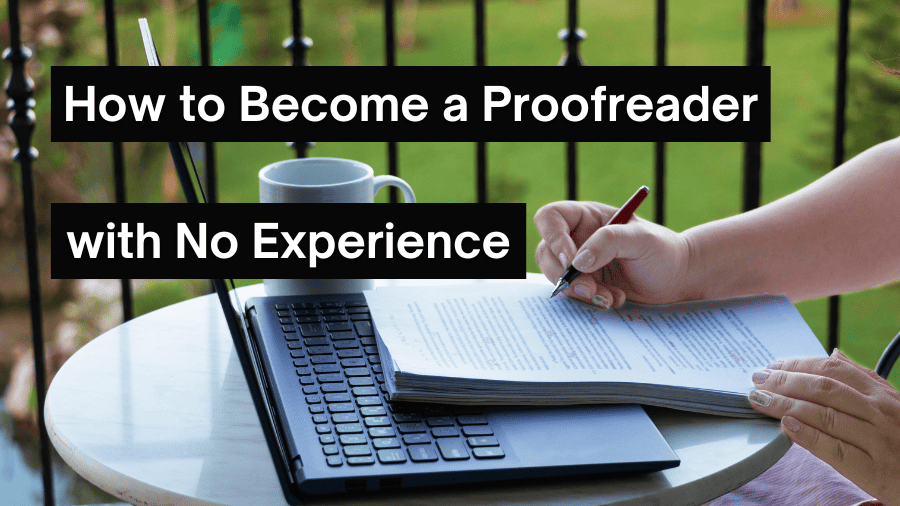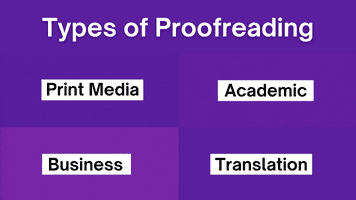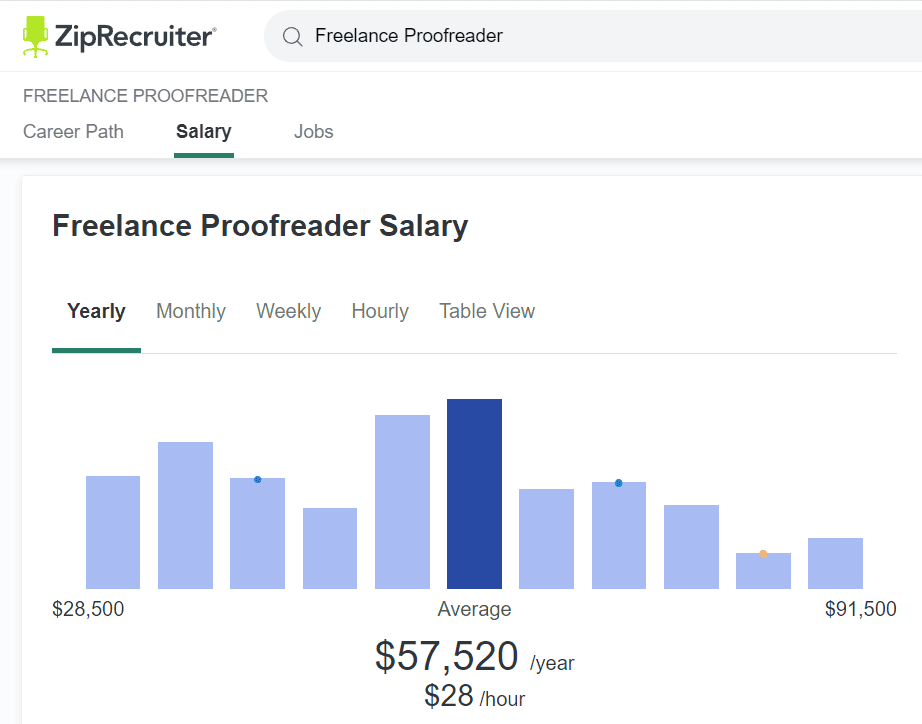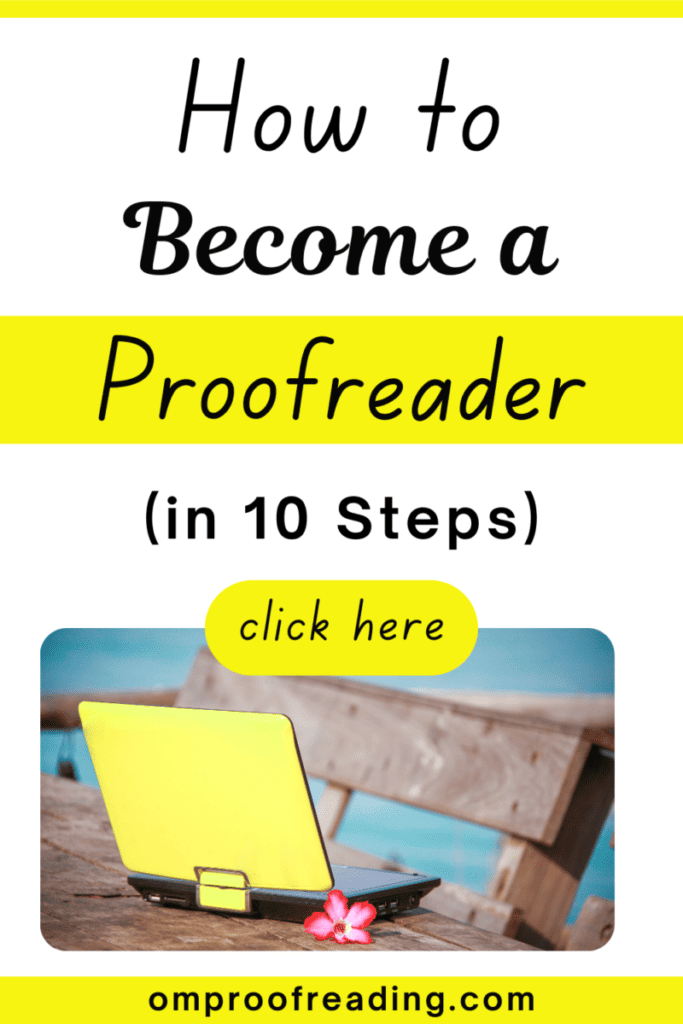This article may contain affiliate links. Please see our affiliate disclaimer in the footer menu for more information. Thank you for your support!

Do you want to become a proofreader so you can get paid to work on error patrol? Fantastic! Although becoming a proofreader takes hard work, you don’t need experience or a degree to make it happen.
As a trained proofreader, I’m happy to show you the ropes so you can start polishing people’s prose. I’ll walk you through everything you need to know, one step at a time. 😊
How to Become a Proofreader with No Experience
Let’s see the steps you need to take to become a proofreader.
1) Understand What a Proofreader Does
A proofreader finds and corrects errors in five main areas:
- punctuation
- grammar
- capitalization
- spelling
- formatting
They also keep their eyes peeled for misused words (e.g., your vs. you’re).
Finally, they ensure the author hasn’t omitted or repeated any words.
Proofreaders do not do any rewriting or restructuring; they focus on minor details.
Let’s briefly compare the role of a proofreader to that of other editorial professionals.
The Proofreader’s Role in the Editorial Process
The editing process consists of four stages, starting with developmental editing and ending with proofreading.
Let’s see who does what so you can get a better idea of the big picture.
The Roles of Specific Editorial Professionals
| Type of Professional | What They Do |
|---|---|
| Developmental Editor | Adds/subtracts/reorganizes entire sections of text to improve the overall content and structure |
| Line Editor | Refines the language to improve flow, clarity, and consistency in style and tone |
| Copy Editor | Makes writing correct, comprehensive, consistent, clear, and concise; fixes mistakes with sentence structure |
| Proofreader | Corrects errors with grammar, capitalization, punctuation, spelling, and basic formatting issues; checks for repeated, omitted, and misused words |
Note: These roles overlap to some degree. For example, copy editors fix the same mistakes as proofreaders, but a copy editor’s focus is broader.
Proofreaders provide the final check for a document before it’s published online or in print.
I’ve always thought of proofreaders as being like the goalie on a soccer team. The goalie is the last line of defense, attempting to stop the ball from entering the net.
Likewise, the proofreader is the final safeguard, trying to prevent errors from reaching the final version of a text.
If you’d like detailed information about the four-stage editorial process and the kinds of mistakes proofreaders look for, please see this article on Om Proofreading.
2) Make Sure Proofreading Is a Good Fit for You

It’s important to do some self-reflection to make sure your abilities and interests align with being a proofreader.
To see if you’re well-suited for this job, consider the following questions:
- Do you have a knack for spotting errors in written content?
- Are you able to work alone and keep yourself on task?
- Do you have good organizational skills?
- Do you love to read?
These questions reflect some of the skills you’ll need to be a proofreader.
I think the most critical skill is the ability to pay attention to details.
If you tend to notice written errors, you’d probably be a good proofreader.
What Skills Does a Proofreader Need?
Let’s learn more about the skills you need to succeed on error patrol.
You may already have many of these skills, but you’ll continue to hone them as you become a proofreader.
- strong attention to detail and capacity to concentrate
- ability to work alone and be an independent thinker
- high level of self-discipline and good organizational skills
- broad general knowledge and a love of reading and learning
- solid research and written communication
- a firm grasp of grammar, capitalization, punctuation, and spelling
- awareness of how to fix formatting issues
- ability to use certain features in specific software (mainly MS Word and Google Docs)
- familiarity with at least one major style guide
- some marketing and money management know-how (for freelancers)
If you’d like additional information about whether proofreading is a good fit for you, I authored an article about the skills needed to be a proofreader.
3) Decide What Kind of Proofreading You Want to Do
Although most people become general proofreaders, some choose to be transcript proofreaders.
If you’re unsure what to select, I’d recommend general proofreading.
Becoming a General Proofreader
Being a general proofreader gives you a solid foundation and allows you to work on a broad range of documents. Many people enjoy having this kind of variety in their work.
General proofreaders work with documents that fall under the primary categories of proofreading:

- print media (e.g., e-books, books, newspapers, magazines)
- academic (essays, research papers, theses, dissertations, etc.)
- business (e.g., reports, emails, website copy, user manuals)
- translation (countless types of texts need proofreading after they’ve been translated)
However, a general proofreading course will not prepare you to be a transcript proofreader.
Becoming a Transcript Proofreader
Transcript proofreaders work with court reporters’ transcripts—the official documents containing what was said during a legal proceeding.
To be a transcript proofreader, you’ll need specialized training.
This type of proofreading requires much more preparation—at least twice as much as needed for being a general proofreader.
If you know this is the route you want to take, I highly recommend the Transcript Proofreading: Theory and Practice™ course offered by Proofread Anywhere.
Another Consideration: Publishing Company or No?
One last consideration is whether you want to work for a publishing house. (Just be aware that there’s a lot of competition for jobs in the publishing industry.)
It’s okay if you’re not sure yet.
But if you know that’s what you want to do, you’ll need to look for a course (we’ll talk about classes soon) that teaches you how to proofread typeset texts.
You’ll encounter typeset documents in the form of books, newspapers, or magazines if you work for a publishing company. These texts are typically proofread using Adobe Acrobat Reader.
Working with typeset documents requires extra training.
For example, you’ll need to identify problems with the text’s layout and ensure the design specifications have been followed.
Do I Need to Learn about Proofreaders’ Marks?
Short answer: probably not.
It’s possible (but quite unlikely) that a publishing company will want you to proofread a hard copy with proofreaders’ marks.
Newer proofreading courses don’t teach these symbols since we don’t use them much anymore.
If you need to know them, you can learn them through self-study.
Being a Proofreader at One of the “Big Five”
You’ve likely heard of the “Big Five” trade book publishers:

- Harper Collins
- Macmillan
- Penguin Random House
- Simon & Schuster
- Hachette Book Group
Some people may want to secure a job at one of the “Big Five.”
However, it’s quite challenging due to exceedingly stiff competition. Not impossible. Just very difficult.
A good bet to get your foot in the door of the publishing industry is to see if a local publisher has an internship or entry-level position available.
Otherwise, you can reconsider this possibility after you gain a few years of experience.
4) Take a Comprehensive Proofreading Course
If you’re serious about making decent money from this line of work, I highly recommend taking a comprehensive and reputable course.
Proofreading is a profession just like any other.
Furthermore, I don’t recommend taking a class that can be completed in a few hours because it won’t provide sufficient instruction.
At the end of this article, we’ll talk about how much proofreaders earn.
I think it’ll be apparent from the numbers that a few hours of training won’t allow you to make that kind of money.
If it did, everyone would be doing it!
And if you only received a few hours of training, you wouldn’t get sufficient real-world practice to prepare you for working with clients.
Finally, you’d find it difficult to compete with proofreaders who received solid preparation.
Om Proofreading has an article about why proofreading courses are worth the investment.

Just make sure to match the class you take with the kind of proofreading you want to do.
Let’s see several options for training.
The Proofreading Courses I Recommend
I recommend one of the following four programs for learning how to proofread:
1) General Proofreading: Theory and Practice™
Proofread Anywhere, based in the US, offers this excellent class. The highlight of this course is that it teaches you how to proofread and build a company and market yourself.
I took the General Proofreading: Theory and Practice™ class for my training, and it prepared me quite well to start a freelance proofreading business.
2) Becoming a Proofreader
Knowadays, a UK-based business, provides this popular class. The Knowadays proofreading course teaches students not only how to proofread documents but also how to enhance their readability and tone.
3) Essential Proofreading: Editorial Skills One
This class is put out by the Publishing Training Centre, which is based in the UK. The advantage of this course is that you’re assigned a personal tutor who assists you throughout your learning.
4) Proofreading 1–3 (Introduction, Headway, and Progress)
The Chartered Institute of Editing and Proofreading, based in the UK, designed this series of three classes:
- Proofreading 1: Introduction
- Proofreading 2: Headway
- Proofreading 3: Progress
The best part about these three classes is that they’re offered by a prestigious name in the publishing world.
I created a detailed review comparing these proofreading programs if you need more information about training.
I also wrote an article comparing the pros and cons of the Proofread Anywhere and Knowadays proofreading courses since these two classes have become the most popular choices.
Do These Classes Provide a Proofreading Certificate?
Proofread Anywhere is the only one of these courses that doesn’t give you a certificate just for completing the training. You need to earn a certificate from that course by purchasing the Ignite Plus version of the class and scoring 90% or higher on the final exam.
5) Allow Ample Time for Training

Many individuals (myself included) find that a proofreading class requires much more know-how than anticipated. You may be surprised by how much you don’t know, and that’s okay!
That said, acquiring adequate skills may take longer than you expect. No one has ever become a proofreader overnight—although obtaining proofreading proficiency through osmosis would be amazing! 😊
If you ever get frustrated or overwhelmed, remember that’s normal when starting something new.
Just think about why you wanted to become a proofreader, and you’ll put some pep back into your step!
Having adequate expertise before you start working will boost your confidence and protect your reputation.
Be prepared to spend at least one month completing a proofreading course.
You’ll Spend Time Becoming Familiar with Software
Fortunately, becoming a proofreader doesn’t require purchasing expensive software or lots of products.
You need a laptop or desktop computer and a stable internet connection to do your work.
If you’re like me and enjoy working around others, you’ll want to opt for a laptop to take to your local library, bookstore, or coffee shop.
You’ll also want a paid version of Microsoft Word.
A free version of MS Word is available online; however, it’s unsuitable for proofreaders due to its limited functionality and inability to ensure the safety of clients’ documents.
You may already be familiar with Word, but proofreaders need to learn how to use a specific feature of Word called Track Changes.
Being familiar with Google Docs and its Suggesting feature is also necessary.
Luckily, Google Docs is free.
Some proofreaders also learn how to use Adobe Acrobat so they can work on PDFs.
But this software isn’t necessary unless you work for a publishing house that uses Acrobat.
Two other tools you may want to eventually obtain are Grammarly and PerfectIt.
You’ll Learn about Style Guides

Knowing how to navigate style guides is an essential proofreading skill.
You need to be familiar with at least one of these four major style guides (for US English):
- The Chicago Manual of Style (CMOS)
- The Associated Press Stylebook
- the Publication Manual of the American Psychological Association
- the MLA (Modern Language Association) Handbook
The principal style guide for proofreading UK English is New Hart’s Rules: The Oxford Style Guide.
These guides contain the rules you need to follow when fixing errors in a document.
The Proofread Anywhere course teaches you how to navigate CMOS. You refer to it as you practice proofreading real-life practice documents.
However, the other proofreading classes I mentioned teach you generic rules with the understanding that you’d refer to the necessary style guide when deciding how to correct mistakes.
The genre of the writing we’re proofreading dictates our style guide, and the style guide dictates the appropriate dictionary.
For example, we use Merriam-Webster’s Collegiate Dictionary, 11th Edition, with CMOS.
In addition to style guides and dictionaries, proofreaders often use other reference books to help them do their job.
6) Make Use of All Your Resources as You Become a Proofreader
Take advantage of everything that will make your learning easier or more productive.
If your course provides an online community for learners, try to participate actively.

The more you help others, participate in discussions, and ask questions, the more you benefit. Your peers are a superb source of inspiration and support.
If you’re struggling with something, you may want to try a tutoring session if that’s an option.
And if it’s been a while since you’ve learned about grammar and punctuation, I highly recommend reading Painless Grammar by Rebecca Elliott.
I read this book before taking a proofreading class, and it helped me immensely to brush up on basic grammar and punctuation.
7) Consider Volunteering to Get Experience

After you acquire a solid set of proofreading skills, you’ll want to continue to get more practice.
Proofread Anywhere recommends that students get experience by joining Distributed Proofreaders.
Distributed Proofreaders make books in the public domain available as e-books that people can access for free via the Project Gutenberg archive.
However, they depend on volunteers to proofread and format the books before making them available to the public.
Your work for Distributed Proofreaders isn’t the same as what you’ll do for clients.
However, it requires many of the same skills (e.g., attention to detail, focus) and is a wonderful way to get more practice.
Highlighting this volunteer experience is a great way to add value to your résumé and attract new clients.
8) Begin Marketing Your Proofreading Services

At this point, you’ll want to consider marketing your services to get your first few clients.
If you can attract your own clients, you can keep 100% of the profits.
However, promoting your own services is more time-consuming than getting clients on freelance marketplaces, where most of the advertising is done for you.
Nevertheless, if you want to keep all the profits, the following tips are for you.
3 Ways to Start Advertising Your Services
The key to landing your first proofreading job is to be proactive and persevere. You’ll also need patience since it takes time to get the ball rolling.
Let’s see a few ways to start promoting your services.
1) Start Your Own Online Proofreading Business
Having an online presence makes you look professional.
Your future clients will be impressed that you’ve taken the time to create your own business.
If you decide to have business cards made, you can list your website address on the cards.
2) Network with Other Proofreaders and Writers

We often overlook the power of networking. Sometimes, being in the right place (a LinkedIn group for proofreaders and editors, perhaps) at the right time can afford you a job offer.
LinkedIn is a perfect place to establish a profile and become a member of relevant groups. This way, you can network with fellow proofreaders and writers who may need proofreaders.
You can make your LinkedIn profile searchable to hiring managers and recruiters—a big plus!
3) Cold Email Clients You’d Like to Work With
Finally, cold emailing is still around for a reason: it works.
Although it may not work immediately, your perseverance will probably pay off if you combine it with a ton of tact.
The advantage of cold emailing is that you can handpick your clients.
Offering them a free or low-cost sample edit is a way to increase your chances of being hired.
A sample edit is when you proofread a small portion (roughly 500 words) of your potential client’s writing.
They’ll better understand the value you provide after reviewing the sample edit.
9) Find Beginner-Friendly Proofreading Jobs
Now it’s time to start the job hunt! Although the options below involve working for someone else, they can be an effective way to break into the field.
You can continue to market your own services while looking for work in one or more of the places mentioned below.
Let’s explore where you can find work as a proofreader without prior experience.
Freelance Platforms
One way to get your first proofreading job is to create a profile on one or more of the following freelance platforms:
- Fiverr
- Freelancer
- Upwork
- Guru
- PeoplePerHour
The advantage of this strategy is that the platform does the marketing for you.
However, these marketplaces keep a small percentage (usually 10%–20%) of your earnings in exchange for advertising your services and processing payments.
Getting your first few clients is the most challenging part of working on these sites.
When I started proofreading on Fiverr, I set my prices low to attract clients.
A few months later, I increased my rates since I had more experience and had accumulated many positive reviews.

I penned a post about how to thrive on Fiverr, which discusses the tactics I used to land those initial hard-to-get clients.
Online Proofreading and Editing Companies
Numerous online proofreading companies hire a pool of proofreaders to complete the work customers need.
Some of these businesses offer online jobs to proofreaders without experience, but most will require you to have at least some experience.
Other requirements can include having a degree, passing a proofreading exam, or both.
Here are a few examples of proofreading and editing services:
- Grammar Chic
- Proofessor
- Writer’s Relief
Job Boards
I know you wouldn’t expect to find jobs on job boards, but I’m here to tell you that you can. The secret is out! 😉
Here are a few popular job boards to check out:
- FlexJobs
- Indeed
- Glassdoor
- SimplyHired
- Media Bistro
You can find local and work-from-home opportunities on many job boards, including the five I just mentioned.
Type “remote” into the job location search bar to pull up freelance opportunities.
You can search most job boards for free, but FlexJobs requires you to subscribe to their site since they take time to vet all companies and positions listed on their board.
Local Publishers
Finally, you can see if publishers in your area happen to have any positions available.
If you’d like to know the specifics about the opportunities listed above (and a few other options), I wrote a post about the best proofreading jobs online for beginners.
I spent a lot of time connecting with many companies listed in the article to ensure they specifically hire proofreaders—not just editors who are also tasked with proofreading.
I also created a post about at-home book proofreading jobs if that appeals to you.
10) Pick a Niche, and Keep Honing Your Skills

Your proofreading niche is your unique selling point.
If you decide to become a transcript proofreader or work for a publisher, you’ve already established your specialty.
But if you’re a general proofreader, it’s a good idea to consider a niche.
I think it usually makes sense to nail down a niche after you’ve worked in the field for a while.
In the beginning, acquiring a steady stream of work can be challenging if you’re too limited in the kinds of documents you’re willing to accept.
You’ll want to take whatever assignments you can get.
Also, working on a variety of texts will ensure that you eventually choose the specialty you’re best suited to. You may even discover you enjoy working on a particular kind of document more than you thought.
Deciding on a proofreading niche before you’ve had sufficient experience is like picking your favorite ice cream flavor from Baskin-Robbins’s 31 original flavors when you’ve only tasted seven.
Choosing a Niche That’s Right for You
Just like Goldilocks chose the porridge that was just right—during her oopsie burglary episode, lol—you want to pick a niche that’s just right for you based on your knowledge and passion.
If you’d like to learn more, I published a post about how and why to choose a niche.
It’ll help you nestle into a niche faster than Goldilocks nestled into Baby Bear’s bed. Well, at least I hope it will. 😊
Continue to Hone Your Skills to Up Your Earning Potential
As a proofreader, you’ll want to take part in continuing education because language changes over time!
New words are continuously added to the dictionary, style guides are occasionally updated, and long-standing terms become improper or outdated.
You’ll learn about some of these changes through your clients who are in the loop—the language loop, specifically.
However, working in the proofreading field requires you to keep riding the wave of language evolution.
Let’s explore four ways to keep learning.
1) Learn from (and Add to) Your Collection of Reference Books
Even as you get proofreading jobs and become more experienced, it’s important to keep sharpening your skills. You can use various proofreading books to do this.

The more adept you become at proofreading, the higher you can set your rates in the future after getting more real-world experience.
Of course, reading good literature is always a productive pastime—it’s a passive way to refine your skills.
2) Take Another Course to Sharpen Your Skills
No matter how much we’ve learned, there’s always room for improvement.
“Once I slow down because I think I have reached my peak, then my skills will go nowhere but down.”
– Bruce Lee
Identify where you’d benefit most from additional practice, and take a short class. I took a grammar course to refresh my knowledge and really enjoyed it.
Small steps forward mean you’re well on your way to becoming a proofreader extraordinaire!
Make sure to add your training to your résumé or CV after you’ve completed it!
3) Take Online Tests for a Fun Way to Keep Practicing
Om Proofreading has a collection of proofreading tests and quizzes to keep your proofreading prowess up to par.
Online quizzes are an engaging way to keep your skills razor sharp.
4) Get Familiar with a New Style Guide
You can take on a broader range of jobs if you become familiar with multiple style guides.
What Qualifications Do Proofreaders Need (and Not Need)?
Let’s start with the qualifications you do not need.
You Don’t Need a Degree to Get Proofreading Jobs
Although a degree can help your chances of being hired, clients will be more interested in your skills than in any degree you may possess.
Some companies require you to have a degree, usually in English or journalism.
However, plenty of opportunities await those who don’t have a degree but have solid proofreading skills.
You Don’t Need a Professional Certification in Proofreading
You don’t need to be certified (i.e., obtain a professional certification) to become a proofreader.
I don’t hold a professional certification, and I don’t know any proofreaders who do.
Nonetheless, Om Proofreading has an article about how to get a professional certification in proofreading if you’re interested.
Just like an accountant must pass a comprehensive and rigorous test to become a CPA, a proofreader has to do the same to become certified. Editors Canada offers the test you’d need to pass.
They recommend you have at least five years of full-time proofreading experience before attempting the exam.
You Don’t Need a Proofreading Certificate, But It Helps
A proofreading certificate helps show proof of your skills, but it isn’t absolutely necessary.
If you’re curious about what one looks like, here’s mine from the Proofread Anywhere program:
It’s important to note that having a proofreading certificate doesn’t make you a certified proofreader.
So what qualifications do you need?
You Do Need a Solid Set of Proofreading Skills
The only qualifications you need are the skills I mentioned at the beginning of this article.
These skills will allow you to provide value to your clients.
And the most crucial thing your clients will care about is what you can do for them!
Frequently Asked Questions
How much can a beginner proofreader make?
A beginner proofreader can expect to make around $12–$18 per hour. But this depends primarily on whether you work for yourself or someone else, your proofreading speed, and the difficulty of the texts you work on.
You can charge more as you acquire additional experience and client testimonials.
For example, according to ZipRecruiter (February 2025), the average yearly salary for a freelance proofreader in the United States is $57,520.
This translates to about $28 per hour and $4,793 monthly.

If you’d like information about the average salary of proofreaders working for employers, please see my article about how much proofreaders make.
This post also discusses factors that determine how much freelance proofreaders get paid.
Are proofreaders still needed?
Yes, proofreaders are still needed.
You wouldn’t come across online proofreading and editing companies if they weren’t. Nor would you see proofreading services offered on freelance platforms.
Proofreading is essential, primarily because subpar written communication reflects poorly on people.
If you want to come across as refined and polished, your words need to be refined and polished too.
Polished writing matters whether you’re a student, a job applicant, or a professional.
Can anyone be a proofreader?
Anyone who enjoys reading, has an eye for detail, can maintain focus, and is willing to complete the necessary training can be a proofreader.
Can I be a proofreader from home?
You can be a proofreader from the comfort of your home. Most people who work on error patrol are self-employed, so they can work wherever they choose.
The only requirement is that they work from a location with a stable and reasonably fast internet connection.
Is proofreading a good side hustle?
Proofreading is a solid side hustle because the startup costs are reasonable, the hours are flexible, it’s pandemic proof, and you can do it just about anywhere.
Furthermore, working as a proofreader helps you improve your written communication skills, which are valuable for numerous jobs!
What are the pros of being a proofreader?
The pros of being a proofreader include having intellectually stimulating work, acquiring better written communication skills, and helping others.
Furthermore, freelance proofreaders can be their own boss, set their own schedule, and work from home.
What are the cons of being a proofreader?
The cons of being a proofreader include meeting deadlines, staying focused for extended periods, working alone, and occasionally dealing with demanding clients and boring documents.
Freelancers also deal with fluctuating earnings and having to charge low fees initially.
I created an article about the upsides and drawbacks of proofreading work if you’d like to learn more.
I hope this article has given you a comprehensive picture of how to become a proofreader without experience.
If this is your goal, I wish you luck and hope the info on Om Proofreading will help make the process as easy as possible.
Best wishes to you!
“Success is not final; failure is not fatal: it is the courage to continue that counts.”
-Winston S. Churchill

Recent Posts
Punctuation is important because it enables us to communicate our message clearly and effectively. Without punctuation, we wouldn’t understand how units of a sentence relate to one another or how...
Although you're probably somewhat familiar with adverbs, you may be unaware of sentence adverbs. As a trained proofreader who has studied the parts of speech, I can help you understand this unique...
